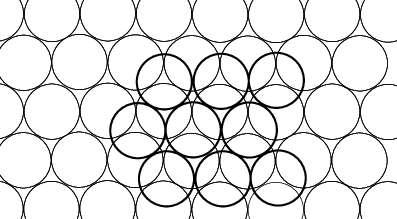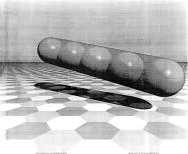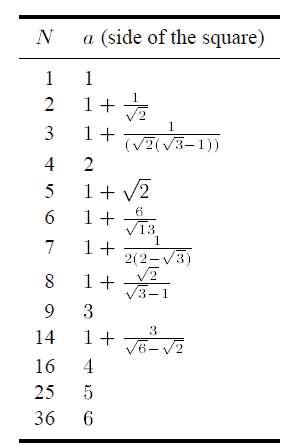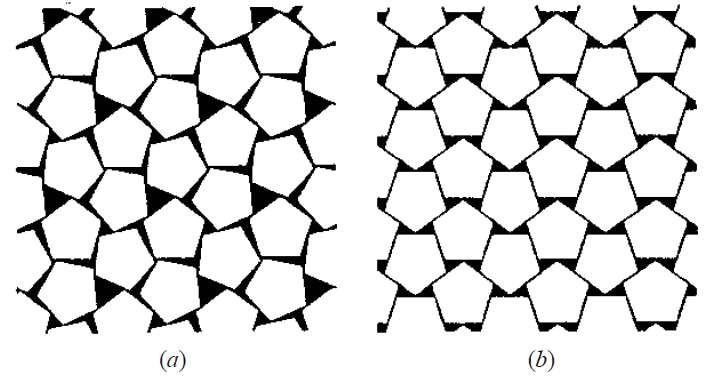




That parking can pose problems should come as little surprise to most of us.
For example, imagine a parking space of length x where cars of unit length are parked one by one, completely at random. What, on average, is the maximum number of cars M(x) that can find a place in this space (without overlapping between cars)?
It is always possible to obtain a packing fraction of one by systematically putting each segment (car) in contact with two others. But if the segments are disposed in a random way without overlapping and readjustment, then after a certain stage the line has no remaining spaces large enough to accommodate another segment.
When cars are parked at random, Rényi1 determined an integro-functional equation that gives M(x) in an implicit form. In the limit of an infinitely large parking space the resulting packing fraction is
The packing fraction ρ and the average of the maximum number of cars are simply related according to M(x) = ρx.
If the random packing is modified so that a car arriving can move slightly (up to half segment length) in order to create an available space, then the packing fraction increases to 0.809.
In the analogous two-dimensional problem, objects with a unit square shape are placed in a rectangular parking lot. In this case no exact results are available.
Figure 13.1. Sausage packing of five balls. (Courtesy of J M Wills, University of Siegen, Germany.)

Palasti (1960) conjectured that the two-dimensional packing fraction has the same value ρ = 0.7475... as in the one-dimensional case. But this conjecture remains unproved and computer simulations suggest that the packing fraction is slightly higher than the conjectured value.
All packings in the real world are finite, even atoms in crystals or sand at the beach. Finite packing problems have boundaries. This makes their solution more difficult than for infinite packings.
How may we arrange N unit discs so as to minimize the area of the smallest convex figure containing all discs (the convex hull)? It has been shown for all N≤120 and for N = 3k^(2)+3k+1, that the convex hull tends to be as hexagonal as possible2.
The analogous problem in three dimensions is: how to arrange N unit spheres so as to minimize the volume of the smallest convex figure containing all spheres? For N≤56 the best arrangements are conjectured to be ‘sausages’ (the centres of the spheres all along a straight line). But larger N convex hulls with minimum volume tend to be associated with more rounded clusters. This might be called the sausage–haggis transition.
For dimension d = 4 it has been shown that the ‘sausage’ is the best solution for N up to at least 377000^(3). The Sausage Conjecture states that for d≥5 the arrangement of hyperspheres with a minimal volume convex hull is always a ‘sausage’4.
When objects are packed in spaces of finite size and of given shape, new questions arise. How many objects can be put inside a given box? Or equivalently, how big
and what is the density of this packing? Is the solution unique?
Let us consider the two-dimensional case first.
Which is the smallest diameter a of a circle which contains N packed discs of diameter 1? The answer to this question is known up to N =10 and conjectures are given for N up to 19. For N = 1the solution is clearly a = 1. For 2≤N≤6 the answer is a = 1 + 1/ sin( π = N), and it is a = 1 + 1/ sin( π /(N - 1)) for 7≤N≤9. Whereas for N = 10 one finds a = 7.747 ...
An analogous problem is to find the smallest size of the square containing N packed unit circles. Exact results are known for N≤9 and N = 14; 16; 25; 36. Conjectures have been made for N≤27.
For large N one has the approximate expression In such a packing the density is, therefore, (13.2)

which tends to the density of the hexagonal lattice for large N. It turns out that for small N the hexagonal arrangement is not the best. Square packing is better adapted to the square symmetry of the container and it results in a denser packing certainly for N≤36 and probably up to N = 495.
2 Wegner G 1986 U¨ ber endliche Kreispackungen in der Ebene Stud. Sci. Math. Hungar. pp 1–28.
3 Gandini P M and Zucco A 1992 On the sausage catastrophe in 4-space Mathematika 39 274–8.
4 See Croft H T, Falconer K J and Guy R K 1991 Unsolved Problems in Geometry (New York: Springer); Wills JM1998 Spheres and sausages, crystals and catastrophes—and a joint packing theory Math. Intell. 20 16–21.
5 See for general reference Melisson H 1997 Packing and Covering with Circles (Proefschrift Universiteit Utrecht, Met lit. opy.).
Beer distributors should look into hexagonal packings now that they sell cases of 18 or more cans: the superiority of square packing is not clear for rectangular boxes6. (See table 13.1, from Croft7.)
Table 13.1. a = 1+1/dN where is the dN minimal separation between the N points in a unit square.

The sphere minimizes the surface area for a fixed volume, as the soap bubble teaches us. In three-dimensional packing problems we need to conside shapes which fit together to fill space, and the problem of minimizing surface area is not so easy. One interesting clue to the best strategy was provided by Michael Goldberg in 1934.
Goldberg restricted himself to the case of a single polyhedron (not necessarily space filling) with N planar sides. What kind of polyhedron is best, in terms of area?
He conjectured that the solution always has threefold (or trivalent) vertices. Bearing in mind the ideal of a sphere, it is attractive to conjecture that the solution is always a regular polyhedron, that is, one with identical faces. This is not always possible. Goldberg’s conjecture, supported by a good deal of evidence, states that the solution is always at least close to being regular, in the sense of having only faces with n and n + 1 edges.
6 18 discs can be hexagonally packed in a pattern made of five lines of 4, 3, 4, 3, 4 inside a rectangular box.
Figure 13.2. Goldberg polyhedra for N = 12 , 14, 15 and 16. They are the building-blocks of the Weaire–Phelan and other foam structures (chapter 7).

In particular, the solutions for N = 12 and 14 are as shown in figure 13.2. Although there is no rigorous chain of logic making a connection with theWeaire–Phelan structure (chapter 7), it turns out to be the combination of these two Goldberg polyhedra.
Pentagons cannot be packed together, without leaving some free space. What is the maximum packing fraction that can be achieved?
There are several obvious ways of arranging the pentagons in a periodic structure. Figure 13.3 shows two of the densest ones. The structure with packing fraction 0.92 is thought to be the densest, and it has been found in the air-table experiments of the Rennes group (section 2.2).
Figure 13.3. Two dense packings of pentagons, with packing fractions 0.864 65 (a) and 0.921 31 (b).

Consider a (not necessarily ordered) packing of equal spheres. Construct around any sphere the Vorono¨ı cell (the polyhedron in which the interior consists of all points of the space which are closer to the centre of the given sphere than to any other, chapter 2). It was conjectured and proved very recently by Hales and McLaughlin that the volume of any Voronoï cell around any sphere is at least as large as a regular dodecahedron with the sphere inscribed. This provides the following bound for the densest local sphere packing This is 1% denser than the Kepler packing but this is a local arrangement of 13 spheres that cannot be extended to the whole space. Indeed, regular dodecahedra cannot be packed in ordinary space without gaps. The situation is similar to that for pentagons in two dimensions. Regular pentagonal tiles cannot cover a floor without leaving any interstitial space. However, in two dimensions one can immediately see that this close packing can be achieved by curving the surface. The result is a finite set of 12 closely packed pentagons that tile the surface of a sphere making a dodecahedron. Analogously, in three dimensions, regular dodecahedra can closely pack only in a positively curved space. In this case regular dodecahedra pack withoutgaps making a closed structure of 120 cells
which is a four-dimensional polytope (that is a polyhedron in high dimensions)8.
It started with liquids, you know. They didn’t understand liquids. Local geometry is non-space-filling. Icosahedra. Trigonal bipyramids. Oh, this shape and that shape, lots of them. More than the thirty-two that fill ordinary space, let me tell you. That’s why things are liquid, trying to pack themselves in flat space, and that’s what I told them. They couldn’t deal with it. They wanted order, predictability, regularity. Silly. Local geometry can be packed, I said, just not in flat space. So, I said, give them a space of constant curvature and they’ll pack. All they did was laugh. I took some liquids to a space of constant negative curvature to show them it would crystallize, and it sucked me up. (Tepper S S Mavin Manyshaped (New York: Ace Fantasy Boks).)

A parsimonious sculptor wants to cut three cylindrical columns from a piece of marble which has the shape of a right triangular prism. How should he cut it in order to waste the least possible amount of marble? The problem is equivalent to that of inscribing three circles in a triangle so that the sum of their areas is maximized.
In 1802 Gian Francesco Malfatti (1731–1807) gave a solution to this problem which thereafter bore his name. Previously Jacques Bernoulli had given a solution for a special case. In due course other great mathematicians were attracted to it, including Steiner and Clebsch. Malfatti assumed that the three circles must be mutually tangent and each tangent to only two sides of the triangle. Under this assumption the Malfatti solution follows as in figure 13.4.
The problem was considered solved and for more than 100 years nobody noticed that the Malfatti arrangement shown in figure 13.4 is not the best. For instance, for an equilateral triangle, the solution of figure 13.5(a) is better than Malfatti’s one shown in figure 13.5(b). Howard Eves (1965) observed that if the triangle is elongated, three circles in line (as in figure 13.5(c)) have a much greater area than those of figure 13.5(d).
Finally in 1967, Michael Goldberg showed that the Malfatti configuration is never the solution, whatever the shape of the triangle! The arrangements in figure 13.5(e,f ) are always better. Goldberg arrived at this conclusion by using graphs and calculations. A full mathematical proof has yet to be produced 9.
8 See for general reference: Sadoc J F and Mosseri R 1997 Frustration G´eom´etrique (Paris: ´ Editions Eyrolles).

Oranges do not spontaneously form close-packed ordered structures but atoms sometimes do. Where is the borderline between the static world of the oranges and the restless, dynamic one of the atoms, continually shuffled around by thermal energy—between the church congregation and the night-club crowd?
At or near room temperature, only objects of size less than about 1 μm are effective in exploring alternatives, and perhaps finding the best. A modern industry is rapidly growing around the technology of making structures just below this borderline, in the world of the ‘mesoscopic’ between the microscopic and the macroscopic.
In one such line of research, spheres of diameter less than a micrometre are produced in large quantities and uniform size using the reaction chemistry of silica or polymers. Such spheres, when placed in suspension in a liquid, may take many weeks to settle as a sediment. When they do so, a crystal structure is formed—none other than the fcc packing of earlier chapters. This crystallinity is revealed by striking optical effects, similar to those which have been long admired in natural opal.
Natural opals are made of silica spheres of few hundred nanometres (1 nm=10^(-9) m) in size, packed closely in an fcc crystalline array. Opals are therefore made of a very inexpensive material but they are valued as gemstones because their bright colours change with the angle of view. This iridescence is due to the interference of light which is scattered by the ordered planes of silica spheres. Indeed the size of these spheres is typically in the range of visible light wavelength (430–690 nm). An important goal of present research in material science is the creation of artificial structures with such a periodicity, in order to tailor their optical properties. Several studies begun in the late 1980s showed that a transparent material can become opaque at certain frequencies provided that a strong and periodic modulation of the refractive index is imposed in space. Structures with these properties have been constructed for microwave radiation but, until recently, not for visible light. With conventional microelectronic techniques it is very difficult to shape structures below 1000 nm (which is 1 m). Artificial opals provide the right modulation in the diffraction index, opening the way to the construction of new ‘photonic band gap’ materials. Photonic crystals are the ingredients for future optical transistors, switches and amplifiers, promising to become as important to the development of optical devices as semiconductors have been to electronics.
A home-made experiment of spontaneous crystallization can easily be performed in two dimensions by putting small beads on a dish and gently shaking it. The result is the triangular arrangement shown in figure 13.6.


Large spheres in a box are not so easily persuaded to form a crystal, but nevertheless shaking them can have interesting effects. It was observed in the 1960s that repeated shear or shaking with both vertical and horizontal motion can increase the density of the packing. Recently a density of 0.67 was obtained in a packing of glass beads of about 2 mmin diameter slowly poured into a container subject to horizontal vibrations 10. This packing consists of hexagonal layers stacked randomly one upon the other with few defects. Spontaneous crystallization into regular fcc packing was also obtained when the starting substrate was forced to be a square lattice.
This packing has the minimum potential energy under gravity. The system spontaneously finds this configuration by exploring the possible arrangements under the shaking. The slow pouring lets the system organize itself layer upon layer. This is analogous to what happens in the microspheric suspensions of a previous section where the sedimentation is very slow and the shaking is provided by thermal motion.
Sorting objects of miscellaneous size and weight is a key industrial process. Filtration, sieving or flotation may be used. With granular materials it is often enough to shake the mixture for some time. This must be done judiciously; vigorousshaking (as in a cement mixer) will produce a uniform mixture. Gentle agitation, on the other hand, can promote the segregation of particles of different sizes. The result is quite surprising: the larger, heavier objects tend to rise! This seems an offence against the laws of physics but it is not. That is not to say that it is easily explained. Numerous research papers, including the teasingly entitled ‘Why the Brazil Nuts are on Top’ have offered theories 11.
Figure 13.7 shows a simulation of the effect. It is thought to be essentially geometric: whenever a large object rises momentarily, smaller ones can intrude upon the space beneath. Such an explanation calls to mind the manner in which many prehistoric monuments are thought to have been raised. Note that the energy increases as the Brazil nut is raised, contradicting intuition and naive reasoning. This is not forbidden, because energy is being continuously supplied by shaking.
By slowly pouring a mixture of two kinds of grain of different sizes and shapes between two narrow layers of glass, one can observe that the grains separate or, under some circumstances, stratify into triangular strips (see figure 13.8). Large grains are more likely to be found near the base of the pile whereas the smaller are more likely to be found near the top. The phenomenon is observable for mixtures of

grains in a wide range of size ratios (at least between 1.66 to 6.66
Figure 13.8. Segregation and stratification in a granular mixture of brown and white sugar poured between two glass plates.
as reported by Makse et al 12). When the large grains have a greater angle of repose13 with respect to the small grains then the mixture stratifies into triangular strips. (This can be achieved by making the small grains smooth in shape and the large grains more faceted.) For instance, a mixture of white and brown sugar works well for this purpose.
Fineberg has suggested that Cinderella could have utilized this spontaneous separation phenomenon (instead of help from the birds) when the step-sisters threw her lentils into the ashes of the cooking fire.

If a suit is to be made from a roll of cloth, how should we cut out the pieces in such a way as to minimize wastage? This is a packing problem, for we must come up with a design that squeezes all the required shapes into the minimum area.
11Rosato A, Strandburg K J, Prinz F and Swendsen R H Why the Brazil nuts are on top: size segregation of particular matter by shaking Phys. Rev. Lett. 58 1038.
12 Makse H A, Halvin S, King P R and Stanley E 1997 Spontaneous stratification in a granular mixture Nature 386 379–82; Fineberg J 1997 From Cinderella’s dilemma to rock slides Nature 386 323–4.
13 The angle of repose is the maximum angle of slope in a pile of sand, beyond which it suffers instability in the form of avalanches.
No doubt tailors have had traditional rules-of-thumb for this but today’s automated clothing industry looks for something better. Can a computer supply a good design?
This type of problem, that of optimization, is tailor-made for today’s powerful computers. The software which searches for a solution does so by a combinatio of continual small adjustments towards the desired goal, and occasional random shuffling of components in a spirit of trial and error—much the way that we might use our own intelligence by a blend of direct and lateral thinking.
A particularly simple strategy was suggested in 1983 by Scott Kirkpatrick and his colleagues at IBM. Of course, IBM researchers are little concerned with the cutting (or even the wearing) of suits, but they do care passionately about semiconductor chip design, where a tiny competitive advantage is well worth a day’s computing14. The components in microchips and circuit boards should be packed as tightly as possible, and there are further requirements and desired features which complicate the design process.

The research in question came from the background of solid state physics. Nature solves large optimization problems all the time, in particular when crystals grown as a liquid are slowly frozen. Why not think of the components of the suit or the chip as ‘atoms’, free to bounce around and change places according to the same spirit of laws which govern the physical world, at high temperatures? Then gradually cool this imaginary system down and let it seek an optimum arrangement according to whatever property (perhaps just density) is to be maximized.
This is the method of ‘simulated annealing’, the second word being taken from the processing of semiconductors, which are often heated and gradually cooled, to achieve perfection in their crystal structure.
The idea was simple and it is relatively straightforward to apply—so much so that incredulous circuit designers were not easily persuaded to try it. Eventually it was found to be very effective, and hence it has taken its place among the optimizer’s standard tools. Its skilful use depends on defining a good ‘annealing schedule’, according to which the temperature is lowered.
The mathematical background to these large and complicated optimization problems is itself large and complicated. Complexity theory often offers the gloomy advice that the optimum solution cannot be found in any practical amount of time, by any program. But, unlike the pure mathematician, the industrial designer wants only a very good packing, not necessarily the best. Beyond a certain point, further search is pointless, in terms of profit. As Ogden Nash said: ‘A good rule of thumb, too clever is dumb’.